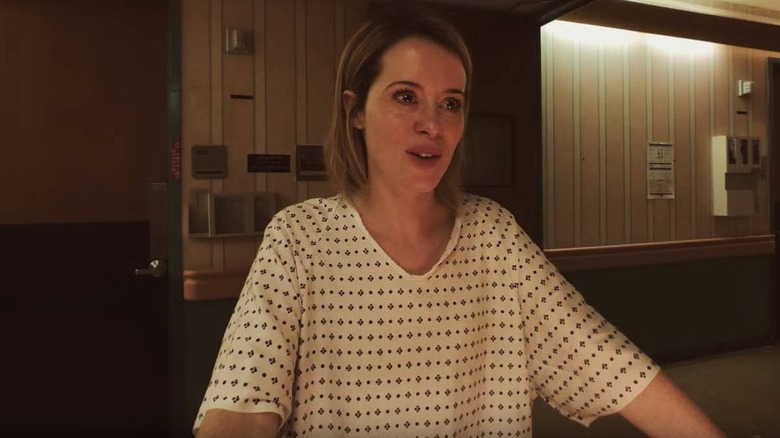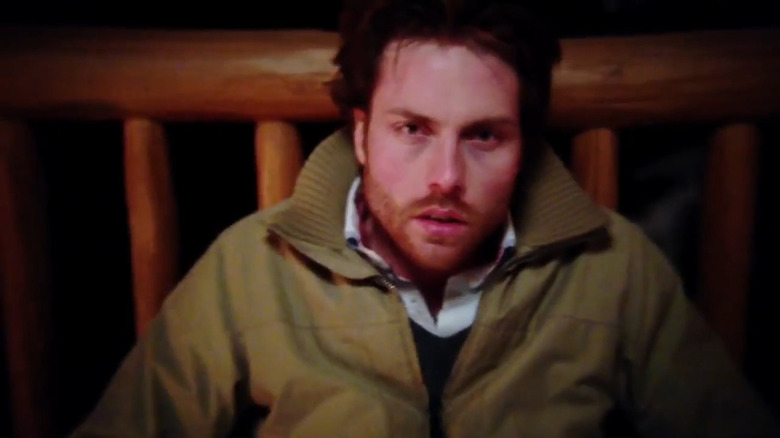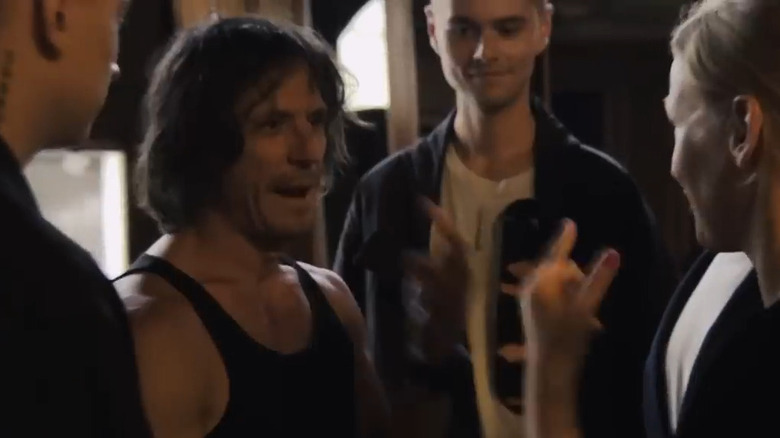'28 Years Later,' Plus 11 Other Movies That Were Shot On An iPhone
The iPhone has become a go-to resource for numerous filmmakers, and not just the ones trying to get their foot in the door. Many world-renowned film directors have discovered the iPhone's potential when it comes to shooting cinematic quality videos, and that includes Danny Boyle for the upcoming "28 Years Later."
Before the first trailer even came out on December 10, the sequel made headlines for Boyle's utilization of iPhones while filming, specifically the iPhone 15 Pro Max. This is in line with stylistic choices made in the past for this franchise. "28 Days Later" was shot on a Canon Xl-1 digital camera, which explains the film's grainier texture. It's a far cry from the Arri Alexa LF that's so commonplace in big blockbusters now, so using an iPhone will undoubtedly give "28 Years Later" a more grounded and primal aesthetic.
Of course, someone didn't just hold an iPhone and hit record. Boyle and his team used various attachments that may be out of reach for up-and-coming filmmakers, but it remains a testament to how the right tools are more accessible than ever before for individuals wanting to tell their own stories. Here are even more movies shot entirely on an iPhone.
Unsane
Back in 2018, director Steven Soderbergh released "Unsane," a thriller about Sawyer (Claire Foy), a woman confined to a psychiatric hospital while she believes her stalker is getting ever-closer to harming her. With a script written in 10 days, a production crew of about a dozen people, and three iPhone 7 Pluses, "Unsane" is a testament to how a solid-looking movie can be pulled off with minimal resources.
However, to make "Unsane" look more cinematic, Soderbergh utilized features in the FiLMiC Pro app. After signing up for a subscription, FiLMiC provides more manual control over a smartphone's camera, granting you better control over focus and shutter speed. FiLMiC continues putting out fascinating features, including Doubletake, which allows you to capture multiple shots at once. FiLMiC also comes with a stabilization feature, but "Unsane" also had a DJI Osmo handy to aid with that.
Soderbergh spoke with IndieWire about his enthusiasm over this new technology and truly believing it's the future of filmmaking. "Anybody going to see this movie who has no idea of the backstory to the production will have no idea this was shot on the phone," he claimed. "That's not part of the conceit."
High Flying Bird
True to his word, Steven Soderbergh filmed his next project "High Flying Bird" on a smartphone, this time an iPhone 8. This was a far more ambitious project. "Unsane" is largely set in one location. "High Flying Bird" is a movie about a sports agent trying to make big moves during a basketball lockout — it's more grandiose, with scenes taking place in many different locales.
Some things remained the same, such as Soderbergh having a DJI Osmo to help with stabilization as well as the FiLMiC app to shoot in 4K. Soderbergh also suped up his iPhone with the Moondog anamorphic lens, which provides greater aspect ratios for more cinematic looks. With all these extra features, Soderbergh didn't have to do much in post-production to make "High Flying Bird" look like a real film.
Perhaps the most interesting aspect of Soderbergh filming "High Flying Bird" on an iPhone with FiLMiC is that he discovered various drawbacks that could prevent other filmmakers from making their projects look as polished as they could.
Soderbergh explained later to IndieWire one problem he noticed: "If somebody walks past a window, or you pan through a light, it, even though it's supposed to be frozen, [the sensor] responds. What makes it even worse is it's not the entire frame that responds, it's pieces of the frame."
He reportedly spoke with Apple about this limitation, and hopefully, this serves as a case study of the importance of communication between artists and those creating their tools.
Tangerine
"Tangerine" is arguably one of the best-known films for being shot on an iPhone. After seeing some well-done short films on Vimeo, director Sean Baker realized an iPhone would be perfect for the story of a transgender sex worker, Sin-Dee Rella (Kitana Kiki Rodriguez), tracking down her boyfriend/pimp after discovering he's been cheating on her. Baker's team had three iPhone 5S smartphones at their disposal, which provided them opportunities to film shots that would've been far more expensive with traditional cameras.
/Film noted during a Q&A with Baker at Sundance that the discreteness of iPhones allowed for filming on buses and subways where permits to shoot would have been otherwise necessary. This helped the movie to stay within its relatively modest $100,000 budget. Baker even noted that at one point, a bus driver did call the cops but only because an argument appeared too real.
Baker was even crafty when it came to getting the proper accessories. The Moondog anamorphic lens was still in a prototype phase when "Tangerine" went into production, trying to raise funds on Kickstarter, but when Baker reached out to Moondog, it sent him three lenses to shoot the movie with. $100,000 is certainly plenty of money a lot of budding filmmakers may not have access to, but the story behind "Tangerine" is a testament to how to bring costs down by being a little sneaky and just asking for what you need.
And Uneasy Lies the Mind
"And Uneasy Lies the Mind" often gets credited as being the first feature-length narrative film to be shot entirely on an iPhone although as we'll see later on in this list, some iPhone-shot films came out prior to it. Regardless, being the first of your kind is never an easy feat, and it apparently took some trial and error to figure out the best way to shoot certain scenes and keep the movie going with their iPhone 5. That included a shortened battery life during scenes shot in extreme cold. Director and cinematographer Ricky Fosheim explained to New Atlas his low-tech solution: "In between takes we would have to place the camera underneath our armpit in order to keep it warm."
Fosheim specifically wanted a grimier feel to the film, which is about two couples in a remote cabin who experiment with drugs, leading to shocking revelations. However, the focus always remains with the tension between what's real and what isn't. The texture and feel of the film appears a little off, signaling to the audience that not everything is as it seems here. It's interesting how movies shot on an iPhone seem to lean toward the psychological thriller genre like "And Uneasy Lies the Mind" and "Unsane."
One other aspect to making the film look just a little off is the utilization of a Turtle Back lens adapter. Dirt regularly got stuck within the lens, which helped give the film an even more grounded aesthetic.
9 Rides
"9 Rides" was actually a backup plan for director Matthew A. Cherry. There was something else he wanted to film, but when the lead actress dropped out, he still wanted to make something. So he got an iPhone 6S and a basic outline of a script, relying mostly on improvisation, and made "9 Rides," a movie about all of the wacky patrons an Uber driver gets over the course of a night.
While an iPhone 6S seems quaint these days, it was the first iPhone model to shoot video in 4K, and Cherry wanted to take advantage of this new handy tech. The difference between 4K and 1080p, which was the resolution found on iPhone 5 models, is night and day. 4K offers four times the resolution. This made is far easier to watch on modern TVs compared to 1080p, which would sometimes look grainy.
Filming with a new iPhone (and new app features for FiLMiC) was a challenge for Cherry and the team. This included figuring out how to use the BeastGrip pro rig since that had also come out only a couple of weeks prior to filming. But when it comes to filmmaking, implementing decisions on the fly is just part of the game.
Ghost
Using iPhones as movie cameras is really just an extension of the more stripped-down styles from the past. Cinéma vérité, popularized in the 1960s, used documentary-style approaches to creating narrative films, foregoing traditional and more "cinematic" techniques. It's appropriate enough that Anthony Z. James, director and writer for 2020's "Ghost," cited cinéma vérité pioneer John Cassavetes as inspiration for his own work.
James used two iPhone 8 smartphones to shoot "Ghost," which is about an ex-con wanting to reconnect with his son. In an interview with Mobile Motion Film Festival, James explained the decision behind using an iPhone: "I felt determined to find the most straightforward way to make this film, and 'Tangerine' was a recent proof of the iPhone's capability to produce image quality adequate for theatrical distribution."
He also relied on FiLMiC Pro, a DJI Osmo, and Moondog anamorphic lenses to help with polishing the movie's look. And while he used some small LEDs for certain shots, much of the film relies on natural lighting.
To Jennifer
If any genre of film lends itself most directly to being filmed on an iPhone, it's found footage horror. In 2013, beating out the aforementioned "And Uneasy Lies the Mind," "To Jennifer" came out, shot entirely on an iPhone 5. It makes sense to use a phone for this particular story, as it's about a man traveling to see his long-distance girlfriend who he believes is cheating on him.
Much of the praise directed toward "To Jennifer" related to how it was made with seemingly little budget. And going off of what director James Cullen Bressack has to say, it doesn't appear a lot of extra tools were used. When speaking with Search My Trash, he admitted he even used the smartphone's microphone: "The microphone on the phone also works surprisingly well and blocks out background noise other than speech, a little interesting fact."
Of course, these days there are plenty high-quality Bluetooth microphones for getting better sound from your phone. But to get the feel of a guy filming himself during a twisted journey, just using an iPhone and everything it comes with was probably the right call.
Sleep Has Her House
One great thing about making a list of movies shot on an iPhone is that it demonstrates how little you need to make a feature-length film. In the case of "Sleep Has Her House," the filmmakers didn't even have actors or dialogue. Instead, the film is composed of shots of nature and animals as a malevolent force sweeps through everything, making for an unnerving experience.
Director Scott Barley filmed "Sleep Has Her House" on an iPhone 6. It may seem like the film would've been easy to make, given it's basically just a series of landscape shots, but it was anything but. Many scenes are actually made up of dozens of different shots laid on top of one another. This led to thousands of hours of rendering time and gave Barley doubts as to whether the movie was even possible. And it wasn't just videos that required rendering.
Barley explained to Film Panic magazine: "The film was roughly 90% shot on my iPhone, the rest being made up of some drawings I did about five years ago whilst studying fine art." The combination of film and paintings is a wholly unique final product with utterly sublime images. Seeing as there's no real narrative, "Sleep Has Her House" is a pretty niche film that won't be everyone's cup of tea, but it definitely doesn't look like anything else out there.
I WeirDO
"I WeirDO" lays its claim as the first feature-length film out of Asia to be filmed and edited entirely on an iPhone. In this case, it's the iPhone XS Max, and it's not just a gimmick, as the phone's features help tell this story thematically.
"I WeirDO" is about a man and woman who begin a romantic relationship upon realizing they share similar symptoms related to germophobia and OCD. They live largely isolated lives, and the iPhone's vertical format lends itself to their claustrophobic lifestyles. However, when the characters' worldviews begin to open up, we start getting wider more horizontally aligned shots. And while the film came out in 2020, it's not directly a commentary on Covid-19 although seeing the main characters wear masks everywhere lends itself to themes of isolation.
Outside of these altering aspect ratios, one might not even be able to tell "I WeirDO" was shot on an iPhone, especially considering how vibrant the color palette is. While other movies shot on an iPhone may look a little grainy, one can't tell for "I WeirDO," which is a testament to the evolution of the iPhone over just a few short years.
Banger
If there's anything to take away from this list, it's that sometimes a smartphone can be the best tool possible for that particular story. A smartphone, especially when it's handheld, lends a level of realism to a story, like the audience is actually watching footage of the characters get into larger-than-life scenarios.
The 2022 Czech film, "Banger," follows a drug dealer who wants to become a rapper but has to sell drugs to get enough money to do so. Director Adam Sedlák explained to Cineuropa why this project lent itself well to being filmed on an iPhone 12 Pro Max rather than another camera: "Rap is street music, and I wanted our movie to be like a street film. Therefore, the choice to shoot on the iPhone was not an effort to save, but rather, above all, it was creative."
"Banger" was shot entirely on an iPhone with help from rigs and lenses. There's even a scene where the rapper/drug dealer Alex (Adam Mišík) talks to his fans live on social media. From those stylistic flourishes to the film's title deriving from modern slang, "Banger" very much feels like a contemporary film aiming to appease younger generations.
Snow Steam Iron
Zack Snyder is an innovative filmmaker who frequently toys with new technologies. For example, the Snyder Cut of "Justice League" released in a 4:3 aspect ratio so that it would work better for IMAX theaters. The Snyder Cut eventually emerged after a family tragedy prompted Snyder to step down from post-production of the theatrical cut of "Justice League." To help he and his family get over his daughter's death, Snyder poured himself into a passion project of sorts — "Snow Steam Iron."
It's a four-minute film about a woman fighting back against her oppressors, released for free on Vero and now available on most video-sharing platforms. But a director of Snyder's caliber obviously had other tools to play with. "Snow Steam Iron" contains overhead aerial shots captured with a DJI drone, and he also used various smartphone rigs, lenses, and mounts throughout. The final result is something purely Snyderian, complete with slow-motion shots and gruesome violence.
Photographer Ansel Adams is often attributed with the following quote: "The single most important component of a camera is the 12 inches behind it." When it comes to filmmaking, that means the specific camera you're using is only a small part of the equation. Whether it's a Blackmagic, Arri, or iPhone, it all comes down to what vision you have in your mind for telling the best story possible.











